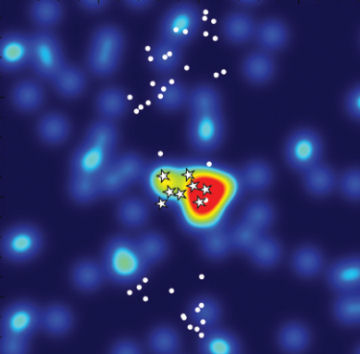Welcome, stranger! A dwarf galaxy that only recently entered our niche in the universe could provide a wealth of insight into how galaxies form and evolve, a new study suggests. The properties of the newfound dwarf provide the best direct evidence that large galaxies in the modern-day cosmos continue to grow by capturing smaller ones.

PRISTINE PART? Colors from blue to red mark increasing density of stars in a newly discovered dwarf galaxy, Andromeda XII. White stars indicate confirmed members of the dwarf, which appears to be on its maiden journey into the Local Group of galaxies (to see a video simulation of in-falling galaxies, click here). |
Discovered last year, the galaxy dubbed Andromeda XII lies 375,000 light-years from the center of the large Andromeda galaxy. Andromeda and our own galaxy, the Milky Way, along with more than 30 smaller galaxies, form the so-called Local Group.
The newfound dwarf galaxy lies at the periphery of the Local Group and is hurtling toward the Milky Way at some 550 kilometers per second, say Scott Chapman of the University of Cambridge in England, Geraint F. Lewis of the University of Sydney in Australia, and their colleagues. From that information, the researchers calculated the galaxy’s orbit.
“In tracing the orbit backwards in time, it is clear that the universe just is not old enough for Andromeda XII to have been ejected from the Local Group of galaxies, gone out, and be on its way back in,” notes Lewis. “Hence, it appears to be falling in for the first time.”
“It has taken the entire history of the universe for the [dwarf] to reach the periphery of giant Andromeda,” adds Chapman. He and his colleagues describe their study in the June 20 Astrophysical Journal Letters.
The leading theory of galaxy formation predicts that the Local Group is still growing by “feeding on [new] material flowing in,” says Lewis. The discovery of Andromeda XII provides evidence for this inflow, he says.
“This is all exactly what we would expect,” says astronomer Heather Morrison of Case Western Reserve University in Cleveland. “New things should be falling in all the time, and because small objects collapse first, we would expect the things that fall in to be dwarfs.”
The finding is intriguing for another reason, adds Lewis. If large galaxies such as the Milky Way have indeed grown bigger by feasting on dwarf galaxies, the chemistry of the two galaxy types ought to match. However, notes Lewis, dwarfs in the Local Group have a higher abundance of elements heavier than hydrogen than do the outskirts of the Milky Way or Andromeda.
One explanation for the chemical discrepancy “is that that the dwarfs we see around us have been interacting with the large galaxies for a long time,” says Lewis. Those interactions could have altered the star-formation histories of the dwarfs and, therefore, their chemical compositions. Finding a seemingly pristine building block like Andromeda XII, which has yet to strongly interact with the Local Group, “would give us a glimpse of what the Milky Way is actually constructed of,” says Lewis.







